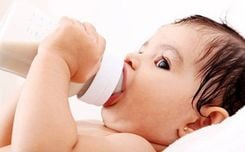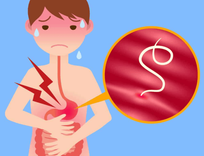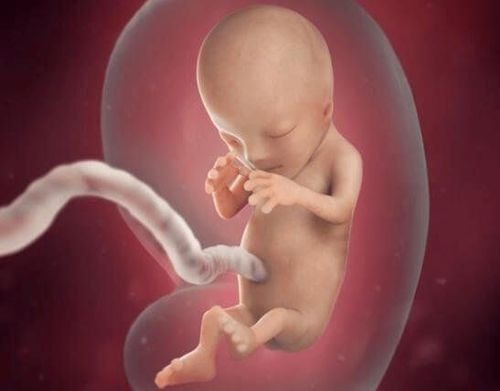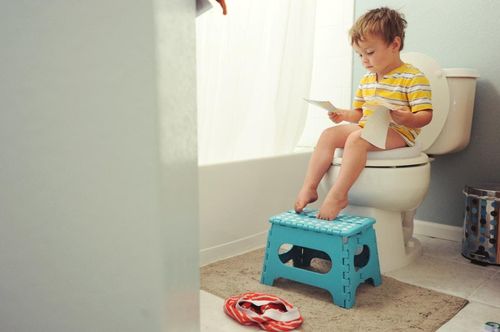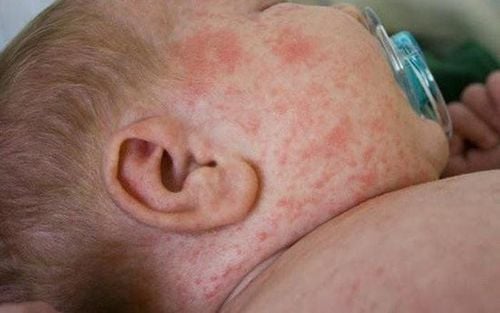Resident Doctor Duong Van Sy, Department of Pediatrics—Neonatology, Vinmec Hai Phong International General Hospital, professionally consulted the article.
Monitoring the head circumference of infants and young children is crucial for assessing their growth and development. Therefore, parents should check it regularly, especially during the early years of life, to ensure timely treatment if necessary.
1. What is head circumference?
For infants, measuring the baby's head circumference is a very important factor besides height and weight. This is one of the important parameters to assess the baby's brain development each month.
Head circumference, also known as occipital frontal circumference, measures the child's head by measuring across the front eyebrows, above the ears on both sides and across the occipital protuberance behind. Based on the development process of the newborn's head circumference, parents can know their child's level of development.
Measuring a newborn's head circumference is often difficult because babies cry often and do not keep their heads still. However, when the most accurate measurement of the baby's head circumference is available, it should be compared with the standard growth chart to determine the baby's growth rate by month of age and gender.
When measuring the baby's head circumference at home, parents can measure the baby's head circumference by using an elastic measuring tape wrapped around the widest part of the baby's forehead, right above the ear, and the middle point of the back of the head. It is recommended to measure regularly once a month on a fixed day to see the baby's growth rate.
The process of measuring the circumference of the newborn's head is often difficult because the baby cries a lot and refuses to keep his head still. But when there is the most accurate measurement of the baby's head circumference, it should be compared with the standard growth chart to determine the baby's growth rate by month and gender.
When measuring the baby's head circumference at home, parents can measure the baby's head circumference by using an elastic band wrapped around the widest part of the baby's forehead, just above the ear and the middle of the back head. It is recommended to measure regularly once a month on a fixed day to see how fast your baby is growing.
2. Growth milestones of the baby's head circumference
The growth rate of the baby's head circumference is usually very fast. From the 20th week of pregnancy until the baby is 3 years old the stage when the baby's brain will begin to develop strongly. During the first 6 months of life, the baby's head circumference will be about 2 cm larger than the chest. From 6 months to 2 years old, a baby's chest and head measurements are usually similar. However, from 2 years old and up, the baby's body size will develop faster than the head size.
To know if the average head circumference of a baby from 0 to 33 months old is developing at the right rate, parents can refer to the information below to check and monitor:
- The baby's head circumference at birth is 34.8 cm;
- The head circumference of a 3-month-old baby is 40 cm
- The head circumference of a 6-month-old baby is 42.4 cm
- The head circumference of an 8-month-old baby is between 43 and 44 cm
- The head circumference of a 12-month-old baby is 45 cm
- The head circumference of a 15-month-old baby is 45.8 cm
- The head circumference of an 18-month-old baby is 46.5 cm
- The head circumference of a 21-month-old baby is 47 cm
- The head circumference of a 24-month-old baby is 47.5 cm
- The head circumference of a 27-month-old baby is 47.8 cm
- The head circumference of a 30-month-old baby is 48.2 cm
- The head circumference of a 33-month-old baby is 48.4 cm.
3. Abnormal signs of head circumference in newborns
A baby's head circumference is not developing normally when it is observed that the baby's head does not increase rapidly or when not within the safe range. A head circumference that is much larger or smaller is an abnormal sign. Specifically:
Abnormally large head circumference: This case may be due to macrocephaly or hydrocephalus, which can cause the baby to have rolling eyes and slow development…
.
The head circumference of a small baby can indicate potential issues with brain development. A smaller head circumference is often associated with brain abnormalities or complications related to brain health…
Measuring the head circumference is a method of checking the health of the baby's development. Therefore, parents should measure the head circumference of newborns regularly until the baby is 3 years old.
In addition, parents also need to supplement their children with essential micro-minerals such as zinc, Lysine, chromium, selenium, vitamin B1, ... to fully meet the nutritional needs of children. Supplementing these essential vitamins also aids digestion, enhances the ability to absorb nutrients, helps improve anorexia, and helps children eat well. Parents can simultaneously apply nutritional supplements through food and natural functional foods for easy absorption by children. The most important thing is that improving symptoms for children often takes place over a long period. Giving a child many types of functional foods at once or frequently changing them can overwhelm their digestive system, making it difficult to adapt, which is not beneficial.
To arrange an appointment, please call HOTLINE or make your reservation directly HERE. You may also download the MyVinmec app to schedule appointments faster and manage your reservations more conveniently.


